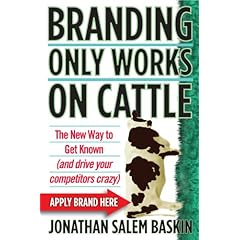It echoes the obsession with media decisions that are simply easier to measure (vis-a-vis conversion rates) alluded to in my prior post about defining viewthrough. Rule #1 of analytics: Just because it is easy to measure doesn’t mean you should – although there are some cynical arguments about job security.
Category Archives: behavioral-based media planning
Branding only Works on Cattle (Proto-Review)
Chicago-based Ad Age writer, author and otherwise brand provacateur, Jonathan Salem Baskin shared a free chapter from his new book, Branding Only Works on Cattle.

In short, after reading Traces in a Cloud Chamber (Chapter 2), I have added BOWOC to my list of books to checkout although I am on a book diet (digital books don’t count).
While I’m not 100% on-board with the notion that branding doesn’t work or only works on farm animals (just got done reading Unconscious Processing of Web Ads by Prof. Chan Yun Yoo), JSB raises some serious issues about the qualitative world of brand effectiveness/efficacy studies. Nicely coinciding with my return to the agency-side of the world, clients have a voracious appetite and need to third-party justify what they anecdotally know works.
Some key thoughts:
- Manifesto? BOWOC sounds like a manifesto for the nascent concept of Behavior-Based Media Planning; More on it here from Atlas Institute and Andy Chen with ClickZ. Agencies have enough challenges to be proactive in this area but it is coming. Every direct marketer (and psychoanalyst) knows that past behavior is a better predicter of future behavior than both attitude and intention.
- Faux-Precision. Qualitative brand voodoo dressed up as quantitative precision…financial analysts and brand equity studies are called to the carpet – loved it. The implied precision of measuring goodwill reminds me of Damon Wayans playing the self-educated prisoner on the 80s TV – Show- in Living Color!
- CLV. Implicit in JSB’s talk of “connections” is Customer Lifetime Value. Such connections or touch points go beyond advertising and marketing to the front-line impact of Cashiers, Clerks, Customer Service and Sales Reps. Having come up in retail ops, this little ditty is rarely acknowledged.
Looking forward to reading more.

